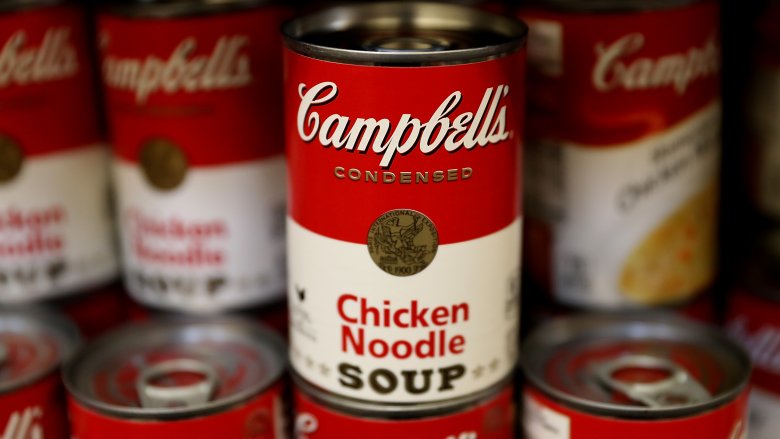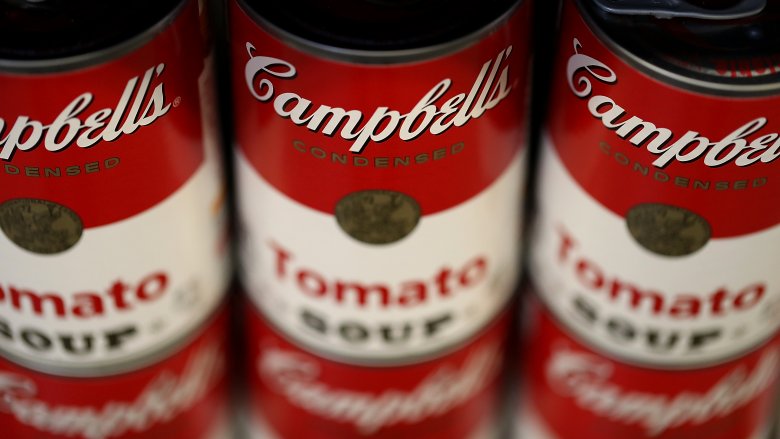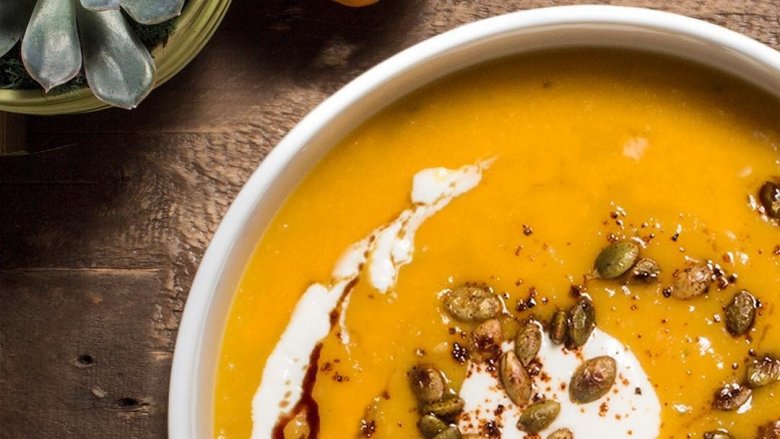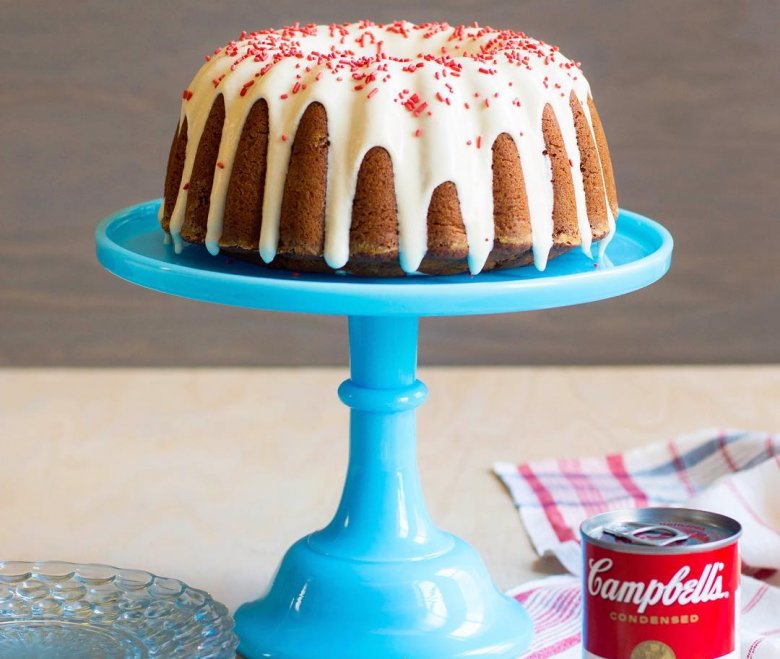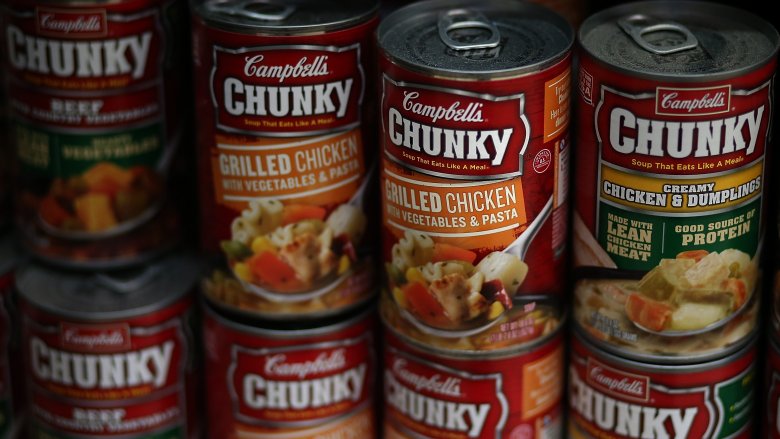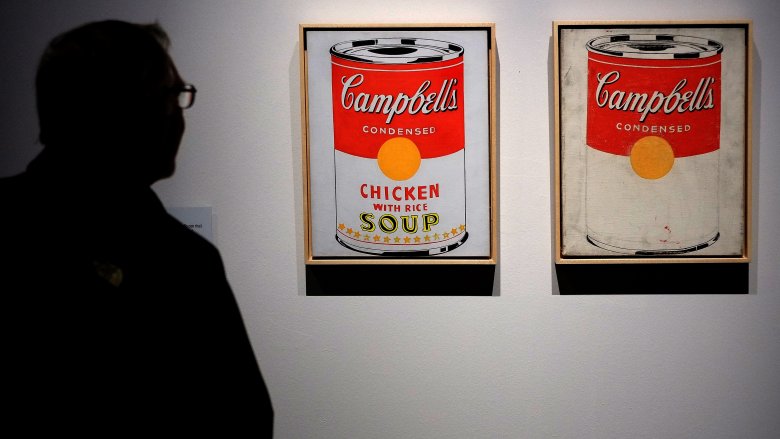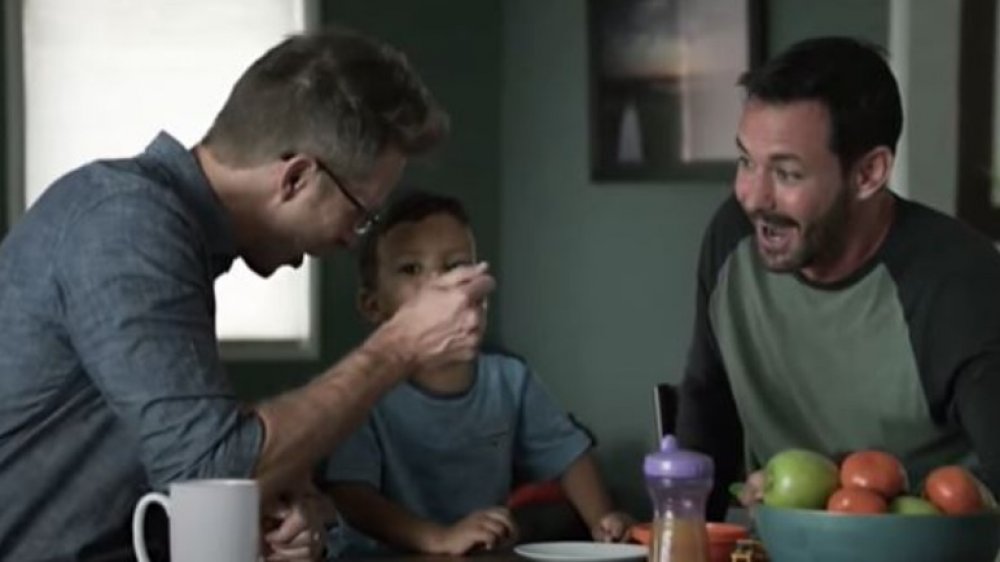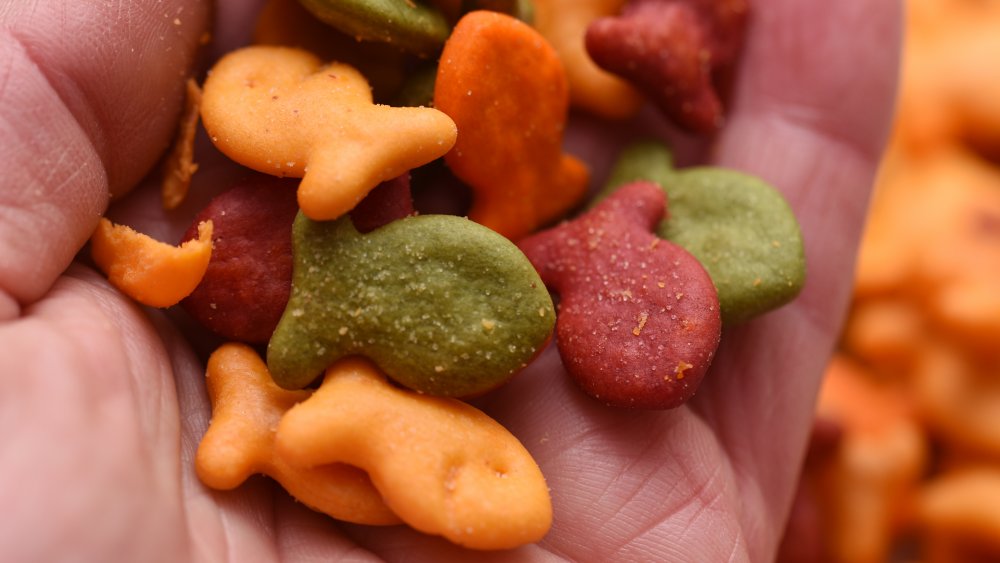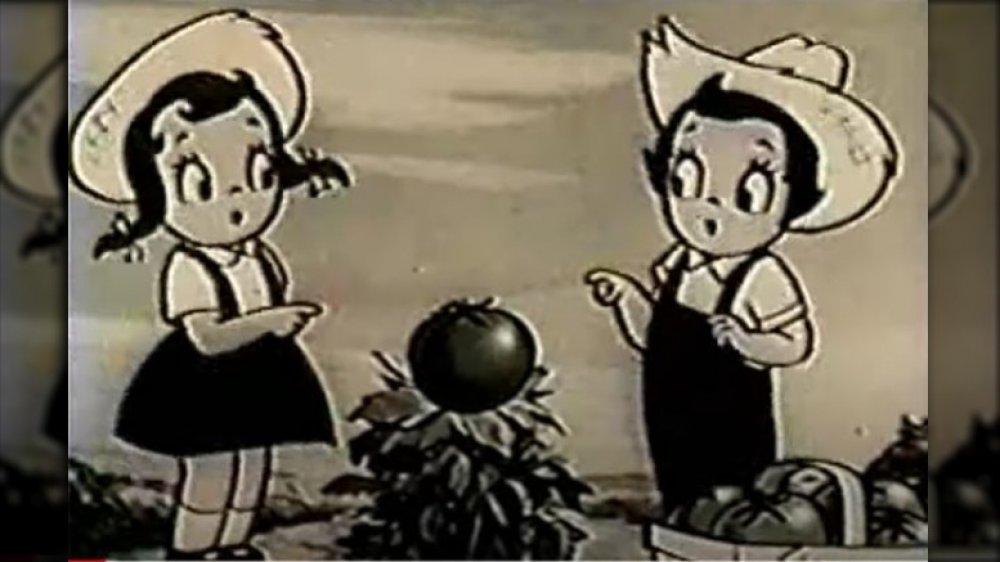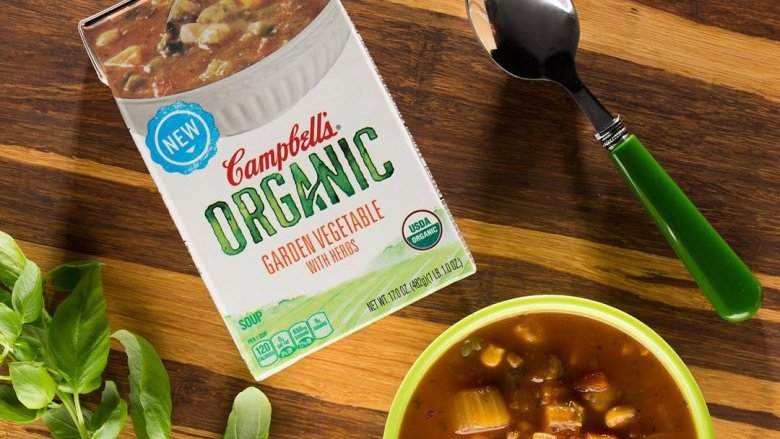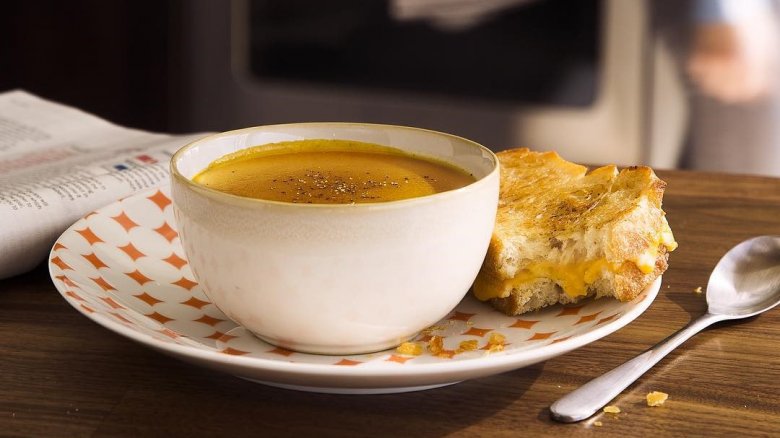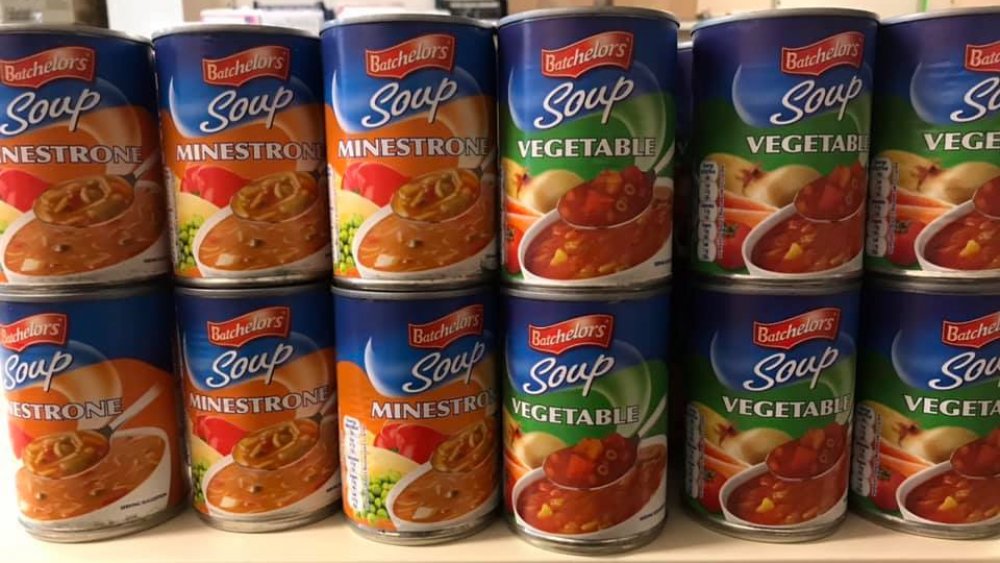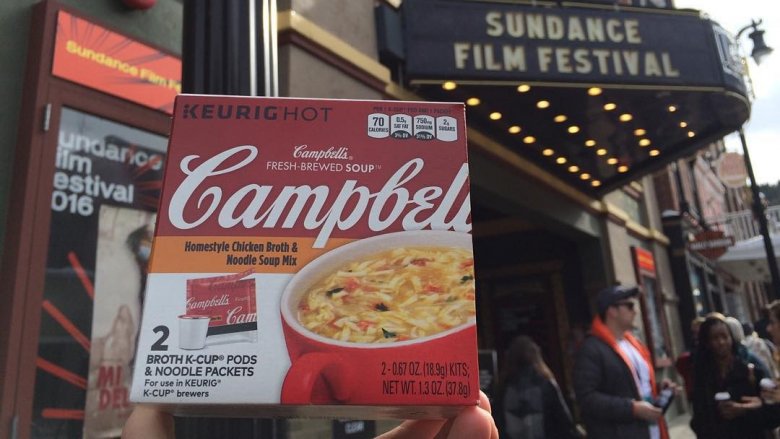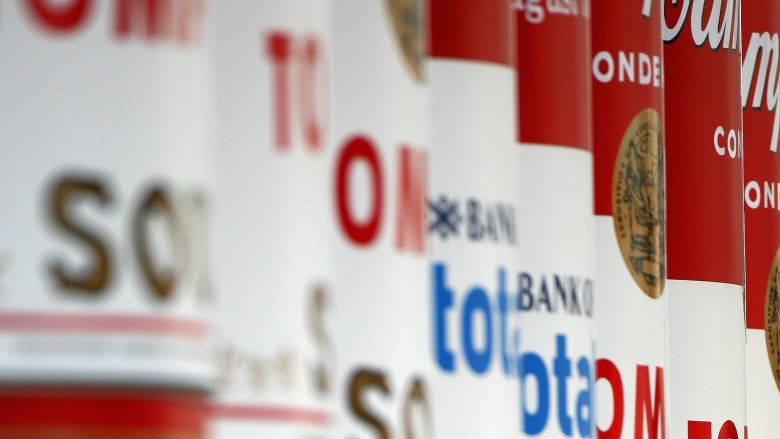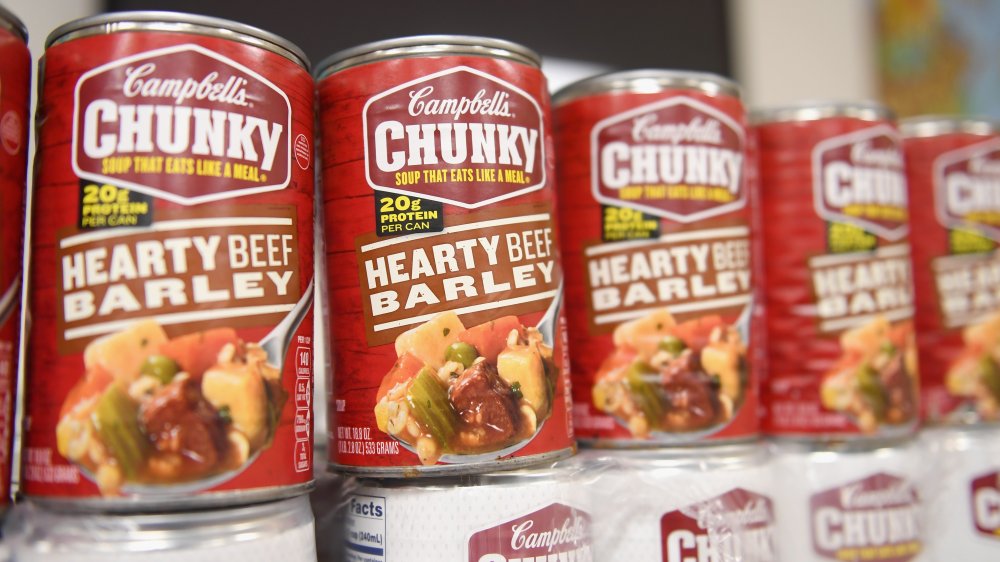The Untold Truth Of Campbell's Soup
If you're anything like us, you'd recognize that iconic red and white label anywhere. How can you not?
It doesn't matter how much of a foodie you are (and what kind of fancy, high-end items you keep your pantry stocked with these days), you probably grew up with at least a can or two of Campbell's Soup in your kitchen. Whether it's nostalgia for days gone by or a true love for what's in the can, there's something comforting about popping open a can of Campbell's soup even today. It's familiar, it's the stuff of childhood, and it's been a part of your life forever. There's still probably some things you don't know about Campbell's Soup, though, so let's talk fun facts.
This is the untold truth of Campbell's Soup.
Those iconic Campbell's soup cans tell a story
The red and white cans were iconic even before Andy Warhol painted them, but they almost didn't look like that at all. According to Food Republic's look at Campbell's branding, they say the original colors of the cans were blue and orange. Campbell's rolled out their condensed soups in 1897, and it was only a year before labels became red and white. Treasurer and GM Herberton L. Williams is credited with making the change after attending a college football game, liking the look of Cornell University's white and red uniforms, and pitching the change. A food icon was born.
There are a few other things you probably didn't know about that iconic label. The distinctive Campbell's font is believed to be based (at least loosely) on the actual signature of company founder Joseph Campbell, and it was meant to convey a down-home sort of feel. That medallion changed in the first few years of Campbell's existence, but the one you're familiar with today is a medal they won at the 1900 Paris Exposition Universelle. They won that medal for excellence, and have kept it ever since.
A chemist condensed Campbell's soup
We're fortunate enough to live in a world of convenience, and it's easy to forget just how revolutionary the idea of condensed soup was. Campbell's was the company that invented condensed soup, thanks to their resident chemist.
Campbell's was founded in 1869, and their first soup plant was located in Camden, New Jersey. It wasn't until 1897 — long after founder Joseph Campbell's retirement — that chemist John T. Dorrance perfected the process for creating shelf-stable condensed soups. Dorrance had quite the foodie background himself. Born in Philadelphia, he studied abroad in Germany before heading to Paris to work in their food industry. While there, he developed the basic idea behind condensed soup. He had the restaurant industry in mind first, and wanted to come up with a way they could buy, ship, store, and prepare soup that was more convenient every step of the way.
That was, of course, condensed soup, and it was great for the home cook, too. Those first cans sold for 10 cents a can in 1897, and remained under a dollar a can until 2012.
Campbell's soup makes good... cake?
Campbell's soup doesn't sound like it would be a key ingredient in a delicious cake, but it absolutely can be. Campbell's says they think it was in the 1920s — during the Great Depression — that inventive home cooks first hit on the idea of using tomato soup to make a spicy sort of cake. It wasn't until 1940 that Campbell's test kitchens released their first version, and it was for a fruit-and-nut, British-style pudding. Not your thing? Have no fear.
By 1942, the fruit had fallen by the wayside and the most popular versions of tomato soup cake were ones heavy with flavors like nutmeg and clove. According to The Kitchn, tomato soup cake was popular during the days of wartime rationing and got a complete makeover after the war years. By the 1970s, bakers were adding cream cheese frosting as the finishing touch, and if you're looking for a spicy, unique cake for that next special get-together, Campbell's soup has you covered.
Campbell's soup reduced their salt... and then added it back
Soup can be one of the healthiest meals you can make at home, but what about the stuff you pour from the can? In 2010, Campbell's soup took some major strides toward lowering the amount of sodium in their soups. A good percentage of their products got a makeover, reducing — on average — the sodium content of each can by about 45 percent. That's a good thing, but Forbes reported only a year later that sales had plummeted so much they were going to be putting the sodium right back in.
For a bit of reference, the American Heart Association recommends limiting sodium intake to no more than 1500 mg per day. Before the change, a single serving of Campbell's Select Harvest soup had around 800 mg, which Campbell's got down to 480 mg. Post-2011, the Los Angeles Times reported those soups were going to be going back up to an average of 650 mg per serving after the brand decided to put more focus on taste. It's still better than it was, so that's something.
Andy Warhol loved Campbell's soup more than you think
Andy Warhol's famous Campbell's Soup Cans art installation is the very definition of pop art. There are 32 canvases, each depicting a different kind of Campbell's soup, and Mental Floss says Warhol did, indeed, love the stuff. He was quoted as saying, "I used to drink it. I used to have the same lunch every day, for 20 years, I guess, the same thing over and over."
No wonder he was so familiar with those cans! They ultimately launched his entire career, and if you look closely at them you'll see they're not all 100 percent identical, in spite of Warhol's attempt to mimic a machine-stamped look.
Campbell's approved of the pieces, too, even issuing a paper Souper Dress inspired by the work.
One of Campbell's soup commercials got big backlash
Star Wars product placement is everywhere, and that includes with Campbell's. In 2015 they partnered for Star Wars themed soups, and they advertised with a commercial starring two dads and their son. The backlash from the far right came almost immediately, and it wasn't because of the questionable Darth Vader impressions. HuffPo reported that One Million Moms were outraged over the commercial, and so were commenters on Campbell's Facebook page.
HuffPo also reported the outrage prompted an epic bit of trolling from Mike Melgaard, who posed as Campbell's customer service and started shutting down the haters (followed by a huge round of applause from a large portion of the general public). The hate was real and it was heartbreaking, he said, especially considering the three people in that commercial aren't just actors, they're a real family.
They're Larry Sullivan, David Monahan, and son Cooper. People says they starred in commercials for Sabra Hummus and Target before appearing in the Campbell's soup ad. By that time, Sullivan and Monahan had been together for around 14 years, and had exactly the sort of family chemistry Campbell's was looking for.
Campbell's owns way more than you think
They might be called "Campbell's Soup," and we might just think of them in terms of those iconic red and white cans, but Campbell's actually owns a massive number of other companies. Many of them are probably on your regular shopping lists, and you might be surprised to learn what else falls under their umbrella.
There are a few things that are still in the realm of soup and lunch — Campbell's also owns SpaghettiOs and (of course) other Campbell's soup lines like Chunky, Healthy Request, Ready Meals, and Slow Kettle Style.
And that makes sense... but not everything else is so easy to connect. They also own Pace, under which they sell salsas, sauces, and dips, Mexican-style. There are Italian-style sauces, too: they also own Prego.
Then, hop over into the drink market. Campbell's Soup owns V8 and V8 Splash, and they also have an organic line of snacks and drinks called Plum Organic.
Finally, the two big ones: they own Pepperidge Farm and Goldfish, too. Who would have thought?
The Campbell's Kids don't look their age
It's not just the Campbell's can that's an iconic part of their branding, there are the Campbell's Soup Kids, too. You've seen them in countless ads, and they don't look their age at all.
For National Soup Month (January)in 2014, Washington University in St. Louis looked at the history of the cherubic little tots. They were "born" in 1904, and they were drawn by children's book illustrator Grace Wiederseim. It was her husband, Theodore, who actually worked in Campbell's advertising department, and when she added the kids to one of his layouts, Campbell's loved it. It wasn't long before the kids were being featured in all Campbell's ads, but we don't know too much about Grace herself. That's partially because she and Theodore divorced in 1911 and she changed her name, but we do know that she helped make Campbell's artwork iconic.
Should you believe the labels on Campbell's soup?
Consumers rely on honest packaging to make all kinds of grocery-store decisions, especially if they're trying to eat healthy. Campbell's had been the target of multiple lawsuits claiming their labeling doesn't quite match up with what's inside the packaging.
In 2013, NJ.com reported on a lawsuit filed against Campbell's that claimed their "Heart-Check Mark" label was misleading, and didn't take into account the high levels of sodium in each serving. (A similar suit was filed in 2010, and Campbell's settled in 2011.) Yet another suit was brought against Campbell's in 2016, when Harold Brower sued after finding out Campbell's paid the American Heart Association for the right to label their products as "healthy." (Top Class Action Lawsuit says the suit was dismissed in 2017.)
Also dismissed was a class action lawsuit filed against Campbell's for the labeling of their V8 juice. While labels clearly state "100% Juice," plaintiffs believed it misled customers into thinking they were buying a product that was 100 percent the juice of the fruits shown, like blueberry-pomegranate. Beverage Daily reports this suit, too, was dismissed, showing just how important it is to read the labels.
Campbell's soup had a hard time with their own retro recipe
Campbell's has been on grocery store and pantry shelves for more than 100 years, but the contents of those iconic cans have changed. In 2016, Campbell's actually rediscovered the old recipe for their beefsteak tomato soup from 1915, and decided to use that recipe for a limited run of 10,000 cans. Those cans would go on sale in New Jersey and Pennsylvania Cracker Barrel locations, and the plan was to follow the old recipe as closely as possible.
That sounds easier than it was, says Fortune, because instructions involved measurements like "a #16 bucket." That meant they had to go back to long-retired employees to get some insight on cooking and preparation methods that were a century old, and ironically, there was only one major change they had to make to the recipe: they cut the salt. A lot.
Campbell's has a confusing history in the UK
Would a soup by any other name taste so good? Campbell's Soup might be a global brand, but there was some seriously strange stuff going on in their UK division in the late 2000s.
For a long time, residents of the UK and Ireland could pick up those same iconic Campbell's Soup cans at the grocery store... until, notes the BBC, 2008. What happened?
Campbell's Soup UK isn't actually owned by Campbell's Soup — it's owned by Premier Foods, who bought the company, but not the brand, in 2006 (for an impressive $830 million). And even stranger, when Premier Foods bought Campbell's Soup, they didn't get indefinite permission to use their name and label — that all expired in 2008, which meant they needed to do some quick rebranding. Campbell's Soup became Batchelors Condensed Soup, and the cans acknowledged it — they read "Formerly Campbell's. Same great taste."
And it was — all the recipes remained unchanged, even though all 22 flavors were renamed.
Fast forward to 2011, and things got weirder. Campbell's announced they would partner with a dry food manufacturer called Symington's to kick off a whole new UK product line — dry soups, instant rice, pasta mixes, and instant cup soups, branded with the familiar Campbell's Soup colors and packaging. That's some serious competition!
Campbell's Keurig efforts failed
Keurigs are pretty polarizing — you either love them or hate them. In 2013, Campbell's banked on more people loving them when they announced they were going to partner with Keurig to make soup in K-cup form. Weird? Absolutely. Gizmodo says they came in two parts, and a single cup of soup meant you needed the K-cup for the broth and a packet of noodles. Unnecessarily complicated? That's also an "absolutely."
It took two years for the product idea to become a reality, and by that time, people were already over the novelty of making soup in a machine you expect coffee to come out of. According to FoodDive, it was only about a year later they announced they were cancelling the product line after dismal sales.
Campbell's soup to your door might be a thing
Even well-established companies need to be on the lookout for how to continually update their product and stay relevant in an ever-changing market, and that's why we saw things like the Campbell's K-cup. In 2017, Bloomberg announced another new chapter that was being written in the Campbell's story, one they hoped would help reverse their declining sales.
People love convenience, and what's more convenient than Campbell's? Campbell's that's delivered right to your door. The delivery service was developed in hopes of connecting with those customers who opt for fresh foods instead of canned, and those cans are also getting a makeover. However, there's no trace of that delivery service on their website as of May 2020, so that testing may not have gone as well as they hoped.
At the same time, they talked about a shift to more local, fresh ingredients, and they were opting for a mason jar packaging to showcase their new soups. Regardless of how trendy mason jars are, we can all agree art history wouldn't be the same without those iconic aluminium cans.
Campbell's is one of the most sustainable companies in the world
If you're trying to make more responsible choices when it comes to your family's purchasing habits, you can be confident in your choice to pick up Campbell's products — just take it from the media and research company Corporate Knights.
In 2019, they named Campbell's Soup to their annual list of Global 100 Most Sustainable Corporations in the World. That's impressive, and more impressive is that they were one of only 22 American companies to make the list, and they were only one of two US-based food companies. (The other was McCormick.)
It's far from their only award, too. After they were recognized by Corporate Responsibility Magazine for the eighth year running, Forbes talked to Dave Stangis, Campbell's Vice President of Corporate Responsibility and Chief Sustainability Officer. According to him, there was a lot going on in 2018 — they were working on shifting more of their company to renewable energy, increasing the amount of recycling they do, and they were doing it all in line with a goal they'd set in 2010 — reduce their environmental footprint by half, by 2020. In addressing Campbell's impressive goals, Stangis had this to say: "[...] find your principles and decide what you stand for. It's a lot more productive to advocate what you're for rather than to argue for things you're against."
